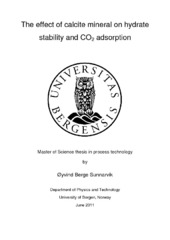The effect of calcite minerale on hydrate stability and CO2 adsorption
Master thesis
Permanent lenke
https://hdl.handle.net/1956/5162Utgivelsesdato
2011-06-01Metadata
Vis full innførselSamlinger
Sammendrag
The background for conducting this study are the huge unused possibilities for storage of large quantities of the greenhouse gas carbon dioxide in old or depleted oil reservoirs or deep brackish aquifers. The method of capture and sequestration of CO2 (CCS) emitted from large point polluters, such as coal power plants, has been presented as a way to alleviate the human effect on the environment. However, it is yet unknown how large quantities of CO2 will affect complex geological formations such as reservoirs. The complexity stems from the presence of different minerals, varying pore distribution and the chemical makeup of the reservoir fluid. The impact that injection of large quantities of CO2 in aforementioned systems poses must be further investigated and understood. This thesis is a first step in such an investigation. The calcite mineral is the most common mineral in the Earth's crust and a major component in most oil reservoirs that are being considered for storage and was considered a prime starting point. Temperature and pressure conditions of many reservoirs could initiate hydrate growth when CO2 is introduced into a water-filled system. The inclusion of hydrate in the system was meant to study the minerals effect on the hydrate stability and growth. In this work, molecular dynamic (MD) simulations have been applied to studies of the interactions and behavior of a model calcite mineral on a composite hydrate/water/CO2 system. In order to study the effects of the calcite on the hydrate stability, the calcite was free to float in the water phase and the CO2 was free to dissolve and interact with both calcite and hydrate. The effect of a calcite crystal on the stability of the hydrate was evaluated to estimate the behavior of hydrate and calcite mineral surrounded by relevant fluids in realistic reservoir conditions. Three versions of the same model system were investigated. The difference between them was temperature and the force fields used to model water. This was done in order to investigate the differences between well-established water models, and how they handled CO2 dissolved in water in the vicinity of a mineral surface. The structuring effects around the incomplete hydrate cages were studied both visually and by radial distribution functions, with the conclusions fully supported by the density profiles. All three systems showed a large degree of water structuring that significantly differed depending on the environment. The adsorption of CO2 in the incomplete half cages of hydrate was found to aid in the hydrate-like ordering of free water on both sides of the hydrate. The CO2 adsorbed in greatest numbers when the width of the water layer was short, the distance required in order to cross a broader water layer and the solubility of CO2 in water reduced the number of adsorbed CO2, yet the CO2 had a strong preference for adsorption to hydrate compared to staying dissolved in water. Water was found to form a layer of molecules around the calcite crystal. This layer has proven itself to be quite stable and have an ordering completely determined by the charge and geometry of the calcite. The potential energies also showed that calcite favored interactions with water rather than CO2. While the properties of the two water models were generally in good agreement with each other in all three systems, the main difference was observed near the calcite crystal. The SPC/E water water model of at 313 K exhibited a much tighter packing of water molecules that re-sulted in attenuating the expected orientation of CO2 molecules toward the calcite. The extent of the calcite’s structuring effect on water was shown to vary depending on the cleaving plane. It was found that the {1014} surface, predominantly found in nature, had exhibited the least structuring effect. This was due to the surface structure of this side consists of a layered structure where the alternating calcium atoms and carbonate ions. These components has a different structuring effect on water, and water molecules are oriented differently depending on which group they are closest to; the adsorbed water layer displayed a large degree of dis-order. Due to this initial disorder the following water layers are not as widely affected by the initial water layer as seen on other surfaces. The size of the crystal together with inherently strong network of hydrogen bonds in water resulted in limited translational and rotational mo-tion for the crystal.
